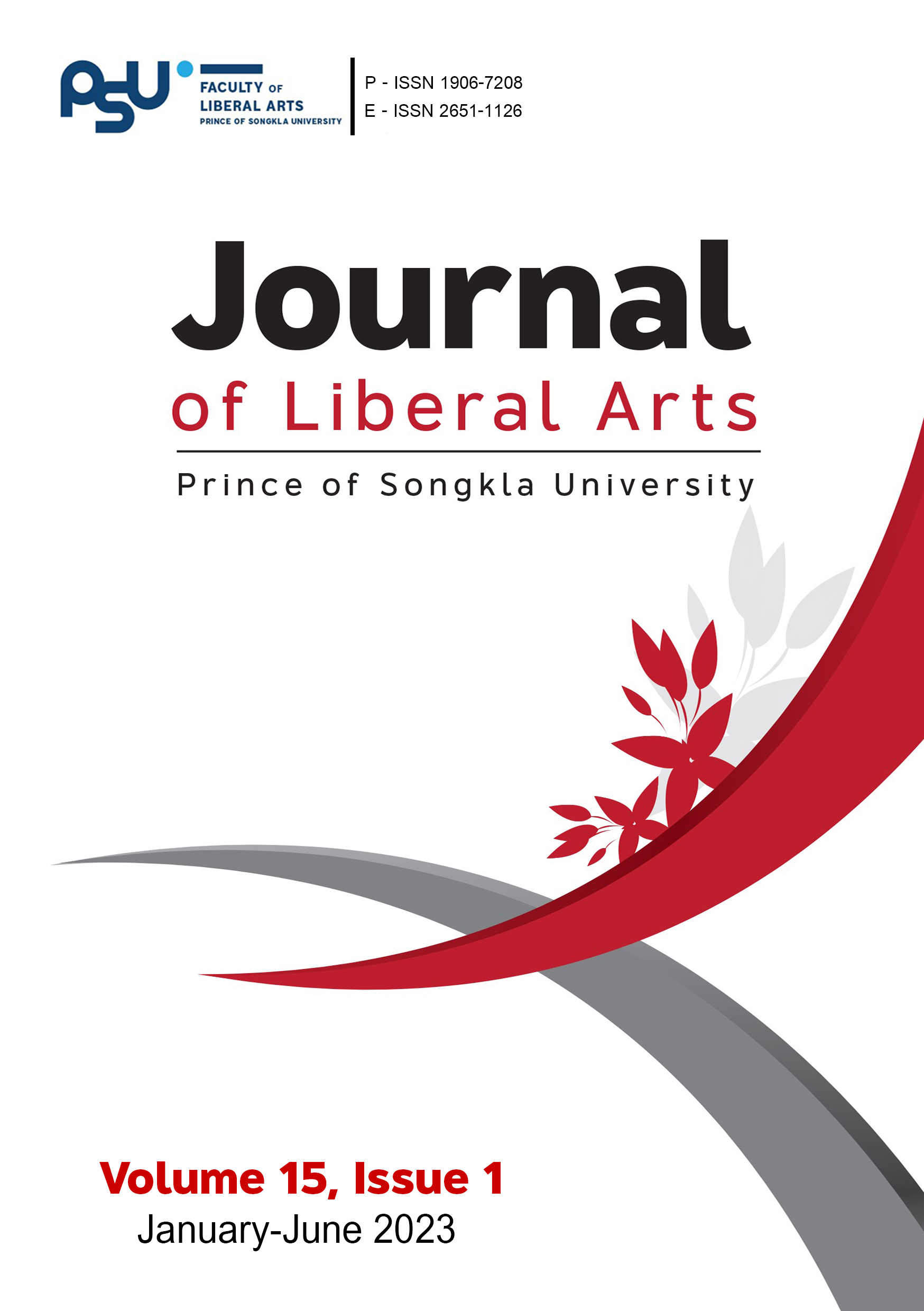Conceptual Metaphors and Metonymies in Chinese American Literary Works
DOI:
https://doi.org/10.14456/jlapsu.2023.4Keywords:
Chinese American, metaphor, metonymy, literary worksAbstract
Metaphors and metonymies, which are types of figures of speech, can be used as the basis to analyze the esthetics of literary works. However, in cognitive linguistics, metaphors and metonymies are also pervasive in our everyday life and reflect human conceptualizations. Employing cognitive linguistics perspectives, this research, is aimed to analyze the conceptual metaphors and metonymies (Lakoff & Johnson, 2003) in two Chinese American literary works: The Joy Luck Club (Tan, 2016) and Battle Hymn of the Tiger Mother (Chua, 2011). Major conceptual metaphors and metonymies were extracted from the two books. The data gained were quantitatively and qualitatively analyzed and categorized into themes. The results revealed that, of all 322 cases found, 83-84% showed
a combination of conceptual metaphors and metonymies. After being classified into 21 theme groups, the analysis revealed that the center of most conceptual metaphors and metonymies was found to be linked to “human.” This finding indicated that conceptual metaphors and metonymies were, most of the time, based on human life and experiences that were pervasive in everyday life. These conceptual metaphors and metonymies are shared universally and play a role in truly understanding culture-specific beliefs and practices, especially in the Chinese American society. It is hoped that better understanding of the commonality gained from this research can help guide future research in cognitive linguistic analysis of other literary works.
References
Angkapanichkit, J. (2019). Discourse analysis. Thammasat University Press. [in Thai].
Chua, A. (2011). Battle hymn of the tiger mother. Penguin Books.
Chunharuangdej, S. (2008). A reflection on Chinese proverbs, idioms, and aphorism. In T. Choksuwanit (Ed.), A collection of articles: proverbs, idioms, aphorism: The studies of families and integrity in international culture (pp. 229-269). Faculty of Arts, Chulalongkorn University. [in Thai].
Dancygier, B., & Sweetser, E. (2014). Figurative language. Cambridge University Press.
Evans, V. (2019). Cognitive linguistics. A complete guide (2nd ed.). Edinburgh University Press.
Feyaerts, K. (2003). Refining the inheritance hypothesis: Interaction between metaphoric and metonymic hierarchy. In A. Barcelona (Ed.), Metaphor and metonymy at the crossroads. A cognitive perspective (pp. 59-78). Mouton de Gruyter.
Hinton, L. (1994). Flutes of fire. Essays on California Indian languages. Heyday Books.
Kanoksilpatham, B. (2023, January 20). Advanced intercultural communication for ELT. A guest lecture at Buriram Rajabhat University.
Lakoff, G. (1990). Women, fire, and dangerous things. What categories reveal about the mind. The University of Chicago Press.
Lakoff, G., & Johnson, M. (2003). Metaphors we live by (1st ed. in 1980). The University of Chicago Press.
Lakoff, G. (2004). Don’t think of an elephant! Know your values and frame the debate. Chelsea Green Publishing Company.
Matisoff, J. A. (1986). Hearts and minds in South-East Asian languages and English: An essay in the comparative lexical semantics of psycho-collocations. Cahiers de Linguistique-Asie Orientale, 15(1), 5-57.
Nagavajara, C. (2020). Theoretical thinking on the basis of the contemporary folk song: A case study of “A young farmer’s admonition to her boyfriend.” In Criticism as precondition of research (1st ed., pp. 39-86). Silpakorn University Press. [in Thai].
Pattana, N. (2020). A reflection of parenting styles and impacts on behaviors of children in The Joy Luck Club. Academic Journal of Humanities and Social Sciences, Burapha University, 28(3), 44-66. https://so06.tcithaijo.org/index.php/husojournal/article
/view/245333/166716
Payungsri, P. (2021). The style of “Niew Klom” in a non-fiction book about “Teacher in the Cookie Shop.” Journal of Liberal Arts, Prince of Songkla University, 13(1), 120-144. https://so03.tci-thaijo.org/index.php/journal-la/article/view/246186
Pinker, S. (2015). Language, cognition, and human nature. Oxford University Press.
Pomsook, A., & Akanisdha, K. (2022). Ontological metaphor translation from English into Thai in the non-fiction book Into the Wild and its translation into the Thai version Kao Pa Ha Chiwit. Journal of Liberal Arts, Prince of Songkla University, 14(2), 1-45.
https://doi.org/10.14456/jlapsu.2022.14
Prasithrathsint, A. (1998). Sociolinguistics (2nd ed.). Chulalongkorn University Press. [in Thai].
Saralamba, C. (2005). Metaphor in cognitive linguistics theory. Journal of Liberal Arts, Thammasat University, 5(1), 1-16.https://
so03.tci- thaijo.org/index.php/liberalarts/article/view/13969/12693
Saralamba, C. (2021). A comparison of HUMANS ARE ANIMALS conceptual metaphor between English and Thai. Journal of Language and Linguistics, 39(1), 128-150.https://so04.tci-thaijo.org/index.php/joling/article/view/249413
Scollon, R., & Scollon, S.W. (2001). Intercultural Communication. A discourse approach (2nd ed.). Blackwell Publishers Inc.
Semino, E. (2008). Metaphor in discourse. Cambridge University Press.
Suwathikul, C. (1995). Unit 4. Literary criticism based on the esthetic theories. Thai 7 (Literary criticism for teachers) (Vol.1, pp.189-243). Sukhothai Thammathirat Open University. [in Thai].
Tan, A. (2016). The Joy Luck club (1st ed. in 1989). Penguin Books.
Tannen, D. (2006). You’re wearing that? Understanding mothers and daughters in conversation. Random House.
Umiyati, M., & Susanthi, G. A. A. D. (2022). Figurative language in Amy Tan’s “The joy luck club.” The 1st International
Student Conference on Linguistics: Trends and Future Perspectives in Linguistics Study, KnE Social Sciences, 179-184. https://doi.org/10.18502/kss.v7i10.11286
Yin, J. (2005). Constructing the other: A critical reading of The Joy Luck Club. The Howard Journal of Communications,
(3), 149-175. https://doi.org/10.1080/10646170500207899
Yuvajita, P. (2008). The relationship in marginal families in America: From the viewpoints of contemporary female poets. In T. Choksuwanit (Ed.), A collection of articles: proverbs, idioms, aphorism: The studies of families and integrity in international culture (pp.171-228). Faculty of Arts, Chulalongkorn University. [in Thai].
Downloads
Published
How to Cite
Issue
Section
License
Copyright (c) 2023 Rungpat Roengpitya

This work is licensed under a Creative Commons Attribution-NonCommercial-NoDerivatives 4.0 International License.
The authors retain the copyright to their article but the Journal of Liberal Arts, Prince of Songkla University reserves the exclusive rights to first publication.






